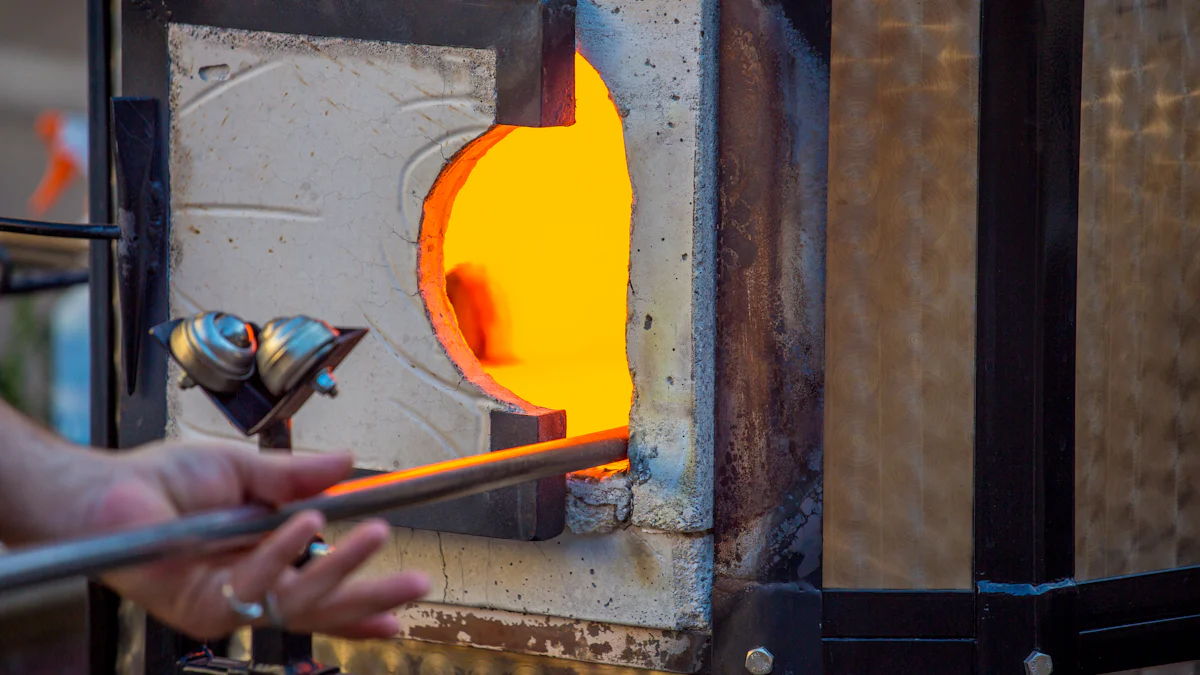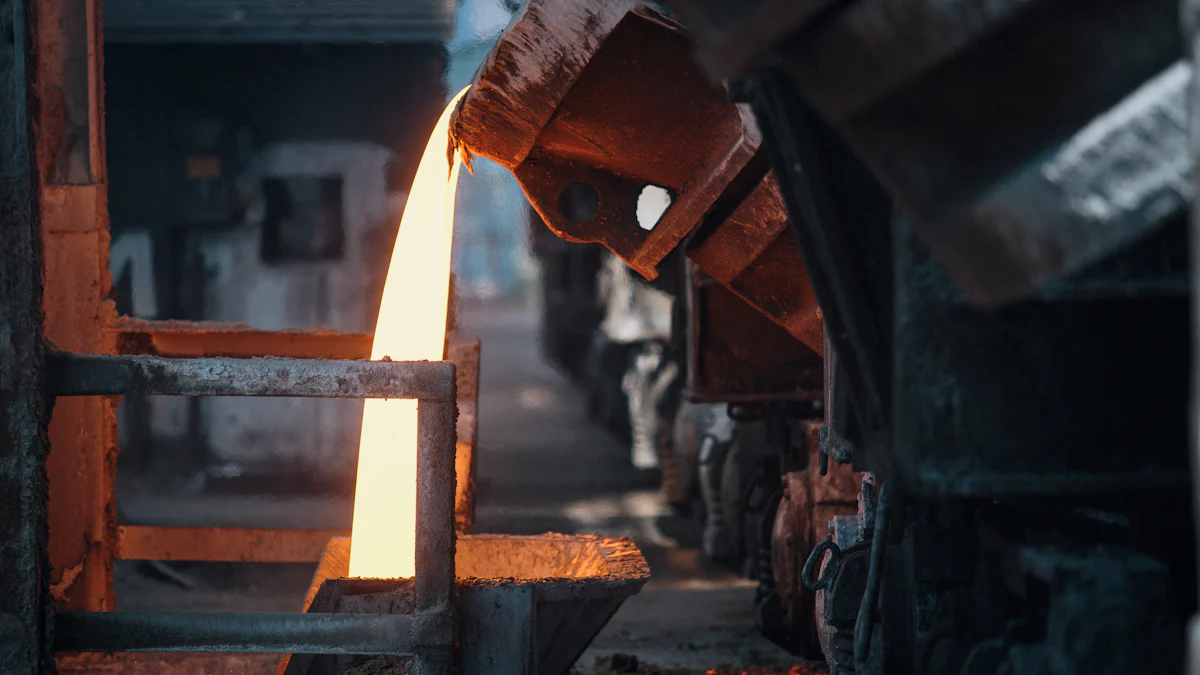
News

Induction heating utilizes electromagnetic fields to directly heat metals, offering exceptional energy efficiency. Unlike conventional methods, it generates heat within the material itself, significantly reducing waste. For instance, induction heating achieves up to 90% efficiency compared to the 50% efficiency of gas heating. This level of precision makes it perfect for various applications, such as induction heater melting metal or when using a portable handheld induction heater. Additionally, an induction heater used for metal provides a reliable and efficient solution for melting and heating tasks.
Key Takeaways
Induction heating works efficiently, using up to 90% of energy. It heats metals directly, unlike older methods that waste energy.
This method gives exact temperature control, perfect for car, plane, and electronics production.
Induction heating is safe and eco-friendly. It removes open flames and harmful gases, lowering fire risks and improving safety.
The Principle of Induction Heating

Understanding the principle of induction heating helps you grasp how this technology efficiently melts metals. It relies on electromagnetic fields to generate heat directly within conductive materials. Let’s explore the science behind it.
Faraday's Law and Electromagnetic Induction
Faraday's Law forms the foundation of induction heating. It explains how changing magnetic fields create electric currents in conductive materials.
A magnetic field interacts with an electric circuit to produce an electromotive force (emf).
The emf is proportional to the rate of change of the magnetic flux through the circuit.
When the magnetic flux changes, it induces an emf in a conductive loop, which is essential for generating heat in induction heating.
Michael Faraday discovered this principle in 1831. His work laid the groundwork for modern applications, including induction heating, which became widely adopted during World War II for efficient metal production.
How Eddy Currents Generate Heat
When you expose a metal to a high-frequency magnetic field, it induces circulating currents called eddy currents. These currents flow within the metal, encountering resistance. This resistance converts electrical energy into heat, raising the metal's temperature. The heat generated is highly localized, allowing precise control over the process. This makes induction heating ideal for tasks like melting metals or heat treatment.
The Role of Hysteresis Losses in Heating
In ferromagnetic materials, hysteresis losses also contribute to heating. As the magnetic field alternates, the material's magnetic domains realign repeatedly. This realignment causes internal friction, which generates additional heat. While hysteresis losses play a smaller role compared to eddy currents, they enhance the overall efficiency of the induction melting principle.
By combining these mechanisms, the principle of induction heating ensures efficient and precise metal melting. This technology continues to revolutionize industries by offering energy-efficient solutions.
Canroon's Induction Heater Melting Metal: How It Works
Components of an Induction Furnace
An induction furnace consists of several key components that work together to achieve high efficiency in metal melting. The primary part is the coil, which generates the electromagnetic field. This coil surrounds the crucible, a container that holds the metal during the melting process. A power supply unit provides the necessary energy to the coil, ensuring the system operates at optimal levels. Cooling systems are also essential, as they prevent overheating and maintain the furnace's performance.
Canroon's induction furnace incorporates advanced IGBT High Frequency Induction technology. This innovation enhances energy efficiency and ensures precise temperature control. The system generates heat directly within the metal, allowing you to target specific areas without affecting surrounding materials. This design preserves the integrity of the metal and reduces energy waste.
The Induction Melting Principle in Action
Understanding how induction furnace works helps you appreciate its efficiency. When you place a metal inside the crucible, the electromagnetic field induces eddy currents within the material. These currents generate heat, causing the metal to melt. Canroon's induction melting furnace ensures precise temperature control, allowing you to achieve consistent results. The process is fast, clean, and highly efficient, making it ideal for applications like induction heater melting metal.
Benefits of Canroon's Induction Heating for Metal Melting
Canroon's induction heating systems offer several advantages for metal melting:
Energy Efficiency: These systems use up to 50% less energy than traditional methods, ensuring high efficiency.
Precise Heating: You can heat specific areas without affecting adjacent regions, which is crucial for applications requiring precise temperature control.
Safe and Clean: Induction heating eliminates open flames and harmful emissions, reducing fire risks and creating a safer work environment.
Reduced Risk of Injury: The non-contact heating method minimizes the chance of burns or accidents.
By combining these benefits, Canroon's induction furnace provides a reliable and efficient solution for melting metals across various industries.
Canroon's Induction Melting Applications in Industry
Induction heating has revolutionized various industries by offering efficient and precise solutions for metal melting. Let’s explore its diverse applications and how it benefits different sectors.
1. Automotive Manufacturing
Precision Casting Techniques
Induction heating plays a vital role in automotive manufacturing. It ensures precise temperature control during metal casting, improving the quality of components like engine blocks and transmission parts. This method enhances casting accuracy, reducing defects and waste.
Efficient Metal Recycling
Recycling scrap metal is another critical application. Induction furnaces efficiently melt recycled materials, conserving energy and reducing environmental impact. This process supports sustainable manufacturing practices in the automotive sector.
2. Aerospace Components
Lightweight Alloy Production
Induction heating is essential for producing lightweight alloys. It ensures precise heating, maintaining tolerances critical for aerospace applications. This process reduces cycle times and improves energy efficiency, making it ideal for forming and shaping components.
Converts up to 90% of electrical energy to heat, saving energy.
Allows precise heating for maintaining tolerances.
Ensures consistent quality through repeatable processes.
Reduces cycle times with rapid heating.
Provides a clean, environmentally friendly process.
High-Temperature Applications
Aerospace components like turbine blades, landing gears, and engine parts benefit from induction heating. This method delivers rapid, localized heating, ensuring durability and performance under extreme conditions.
Landing gears
Turbine blades
Engine parts
Composite materials
3. Jewelry and Precious Metals
Gold and Silver Melting
Induction furnaces offer efficient and rapid melting for precious metals. They achieve high temperatures with minimal energy waste, ensuring precise temperature control. This method produces high-purity gold and silver, meeting the demands of jewelry manufacturers.
Custom Alloy Creation
Induction heating enables the creation of intricate alloys with precise compositions. Its non-contact nature ensures even melting, resulting in superior-quality alloys for custom jewelry designs.
Fast, localized heating ensures even melting.
Precise temperature control maintains material properties.
Clean processes enhance the purity of finished products.
4. Industrial Equipment
Tooling and Machinery Parts
Induction heating improves the durability of tooling and machinery parts. It enhances surface hardness, wear resistance, and fatigue strength, ensuring reliable performance.
Heat Treatment Processes
Induction heating is widely used for heat treatment processes like annealing, hardening, and brazing. These applications improve the strength and durability of industrial equipment.
5. Electronics Manufacturing
Soldering and Bonding
Induction heating enhances soldering and bonding processes by providing precise, localized heat. This method increases production rates and reduces defect rates, ensuring reliable results.
Faster than traditional methods like torch heating.
More energy-efficient than conventional techniques.
Ensures repeatable results with minimal damage to surrounding substrates.
Component Fabrication
In semiconductor production, induction heating is used for annealing processes. It improves the electrical and structural properties of components, ensuring high-quality fabrication.
Induction heating continues to transform industries with its energy-efficient and precise applications. From automotive manufacturing to electronics, its versatility makes it a cornerstone of modern metalworking.
Induction heating stands out as a cutting-edge technology for melting metals. Its non-contact process generates heat directly within materials, minimizing energy loss and ensuring precise temperature control. You can rely on this method for energy efficiency, reduced emissions, and pinpoint accuracy. Industries like automotive, aerospace, and electronics increasingly adopt it for its versatility and eco-friendly benefits.
Advancements in this field promise even greater efficiency. Intelligent control systems and AI optimize real-time monitoring. Hybrid heating technologies and additive manufacturing expand its capabilities. These innovations ensure induction heating remains a cornerstone of modern metalworking, offering sustainable and cost-effective solutions for the future.
FAQ
What is induction heating, and how does it work?
Induction heating uses electromagnetic fields to heat metals directly. The process generates heat within the material, making it efficient and precise for applications like the melting system.
Why does induction heating achieve high efficiency compared to traditional methods?
It minimizes energy loss by heating only the target material. This direct heating approach ensures improved energy efficiency and reduces waste during the melting system process.
Can you use a crucible induction melting system for all metals?
Yes, you can melt most conductive metals using a crucible induction melting system. However, the melting system's efficiency depends on the metal's properties and the induction heating device.
Please give us a message